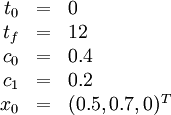Difference between revisions of "Lotka Volterra fishing problem"
From mintOC
| Line 4: | Line 4: | ||
This problem was set up as a simple benchmark problem. Despite of its simple structure, the optimal solution contains a singular arcs, making the Lotka Volterra fishing problem an ideal candidate for benchmarking of algorithms. | This problem was set up as a simple benchmark problem. Despite of its simple structure, the optimal solution contains a singular arcs, making the Lotka Volterra fishing problem an ideal candidate for benchmarking of algorithms. | ||
| + | |||
| + | In this problem the Lotka Volterra equations for a predator-prey system have been augmented by an additional linear term, relating to fishing by man. | ||
== Model dimensions and properties == | == Model dimensions and properties == | ||
| Line 13: | Line 15: | ||
n_x &=& 3\\ | n_x &=& 3\\ | ||
n_z &=& 0\\ | n_z &=& 0\\ | ||
| − | n_u &=& 1\\ | + | n_u &=& 0\\ |
| + | n_w &=& 1\\ | ||
n_p &=& 0\\ | n_p &=& 0\\ | ||
| + | n_{\rho} &=& 0\\ | ||
n_c &=& 0\\ | n_c &=& 0\\ | ||
n_{r^\mathrm{i}} &=& 0\\ | n_{r^\mathrm{i}} &=& 0\\ | ||
| Line 21: | Line 25: | ||
</math> | </math> | ||
| − | It is thus an [[ordinary differential equation|ODE]] model. The interior point equality conditions fix the initial values of the differential states. | + | It is thus an [[ordinary differential equation|ODE]] model with a single integer control function. The interior point equality conditions fix the initial values of the differential states. |
| − | == | + | == Mathematical formulation == |
| + | |||
| + | For <math>t \in [t_0, t_f]</math> the mixed-integer optimal control problem is given by | ||
| + | |||
| + | <math> | ||
| + | \begin{array}{llcl} | ||
| + | \displaystyle \min_{x, w} & x_2(t_f) \\[1.5ex] | ||
| + | \mbox{s.t.} & \dot{x}_0(t) & = & x_0(t) - x_0(t) x_1(t) - \; c_0 x_0(t) \; w(t), \\ | ||
| + | & \dot{x}_1(t) & = & - x_1(t) + x_0(t) x_1(t) - \; c_1 x_1(t) \; w(t), \\ | ||
| + | & \dot{x}_2(t) & = & (x_0(t) - 1)^2 + (x_1(t) - 1)^2, \\[1.5ex] | ||
| + | & x(0) &=& x_0, \\ | ||
| + | & w(t) &\in& \{0, 1\}. | ||
| + | \end{array} | ||
| + | </math> | ||
== Initial values and parameters == | == Initial values and parameters == | ||
| + | |||
| + | <math> | ||
| + | \begin{array}{rcl} | ||
| + | t_0 &=& 0\\ | ||
| + | t_f &=& 12\\ | ||
| + | c_0 &=& 0.4\\ | ||
| + | c_1 &=& 0.2\\ | ||
| + | x_0 &=& (0.5, 0.7, 0)^T | ||
| + | \end{array} | ||
| + | </math> | ||
== Reference Solutions == | == Reference Solutions == | ||
== Source Code == | == Source Code == | ||
| + | |||
| + | <code><pre> | ||
| + | double ref0 = 1, ref1 = 1; /* steady state with u == 0 */ | ||
| + | |||
| + | rhs[0] = xd[0] - xd[0]*xd[1] - p[0]*u[0]*xd[0]; | ||
| + | rhs[1] = - xd[1] + xd[0]*xd[1] - p[1]*u[0]*xd[1]; | ||
| + | rhs[2] = (xd[0]-ref0)*(xd[0]-ref0) + (xd[1]-ref1)*(xd[1]-ref1); | ||
| + | </pre></code> | ||
== Miscellaneous == | == Miscellaneous == | ||
Revision as of 11:54, 29 June 2008
This problem was set up as a simple benchmark problem. Despite of its simple structure, the optimal solution contains a singular arcs, making the Lotka Volterra fishing problem an ideal candidate for benchmarking of algorithms.
In this problem the Lotka Volterra equations for a predator-prey system have been augmented by an additional linear term, relating to fishing by man.
Model dimensions and properties
The model has the following dimensions:

It is thus an ODE model with a single integer control function. The interior point equality conditions fix the initial values of the differential states.
Mathematical formulation
For ![t \in [t_0, t_f]](https://mintoc.de/images/math/5/5/8/55823791d9100bcb5461801aff4f6edd.png) the mixed-integer optimal control problem is given by
the mixed-integer optimal control problem is given by
![\begin{array}{llcl}
\displaystyle \min_{x, w} & x_2(t_f) \\[1.5ex]
\mbox{s.t.} & \dot{x}_0(t) & = & x_0(t) - x_0(t) x_1(t) - \; c_0 x_0(t) \; w(t), \\
& \dot{x}_1(t) & = & - x_1(t) + x_0(t) x_1(t) - \; c_1 x_1(t) \; w(t), \\
& \dot{x}_2(t) & = & (x_0(t) - 1)^2 + (x_1(t) - 1)^2, \\[1.5ex]
& x(0) &=& x_0, \\
& w(t) &\in& \{0, 1\}.
\end{array}](https://mintoc.de/images/math/e/9/3/e93178d5bd1af2eb33e434a69e6883c7.png)
Initial values and parameters

Reference Solutions
Source Code
double ref0 = 1, ref1 = 1; /* steady state with u == 0 */
rhs[0] = xd[0] - xd[0]*xd[1] - p[0]*u[0]*xd[0];
rhs[1] = - xd[1] + xd[0]*xd[1] - p[1]*u[0]*xd[1];
rhs[2] = (xd[0]-ref0)*(xd[0]-ref0) + (xd[1]-ref1)*(xd[1]-ref1);